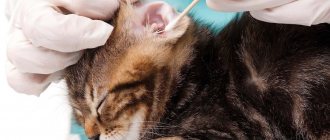It is easier to accustom a small kitten to water procedures than an adult. Owners of a sexually mature animal are faced with the following problem: how to bathe a cat if it is afraid of water.
Experienced breeders advise gradually accustoming your pet to bathing, not forgetting about little tricks.
You should act carefully, without forcing your pet, without showing aggression.
Patience and a friendly attitude will help you find contact even with an adult wayward animal.
Maintenance and hygiene of cats
The cat is characterized as a clean and tidy animal that regularly performs hygienic care for its fluffy fur.
But, due to physiological characteristics, not all parts of the body are accessible to the pet, so her beloved owner comes to her aid. It so happens that cats, by natural instinct, are very afraid of water. And if some representatives of the genus tolerate bathing procedures more loyally, others create a real problem for their owners. At the sight of a basin of water, the cat begins a real battle: it tries with all its might to escape from the person’s hands, scratches, bites and has absolutely no control over its actions.
To calm down the furious ardor of a frightened animal, one has to use physical force, which is not very correct in relation to it. Is it possible to wash a cat in a calm environment, without violent actions towards it and injuries in the form of bites and scratches on the owner?
Important points to remember when washing your cat
A good owner must know and take into account the physiology of his pet. This also applies to the issues of his bathing:
- you should refrain from unnecessarily frequent bathing procedures, because due to the systematic removal of the natural fatty film, the natural protection of the pet’s skin and coat is disrupted;
- You should not bathe an animal that has recently eaten. At least three hours should pass from eating to bathing;
- representatives of long-haired breeds are recommended to be combed before washing;
- under no circumstances should the animal be allowed to be immersed in water with its head;
- If the cat has stained its paws with resin or paint, you should wipe them with a piece of soft cloth soaked in olive oil, and then rinse them with water and shampoo.
Proper care of your furry family member will help you avoid mistakes that could negatively affect his health.
How and with what to wash a cat if it is afraid of water and scratches
Is your cat terribly afraid of water, but, meanwhile, has been in need of washing for a long time? We will tell you how to make this easy and painless for all participants of the upcoming event.
In the bathroom
If you decide to wash your cat in the bathtub, and there is no one to help you, we recommend purchasing a special clamp in the form of a collar on a cord, at the other end of which there is a suction cup for attaching to the wall of the bathtub. The retainer does not prevent the animal from moving freely, but does not allow it to escape from the bathroom and hide somewhere. This is an indispensable remedy for those who do not want to limit the freedom of their pet, but are forced to resort to water procedures from time to time.
In the basin
A very dirty cat, which is frightened by the mere sight of water and flatly refuses to even go into the bathroom, can be washed in an ordinary plastic basin. If it is tall enough and stable enough, you can easily handle this task yourself. Otherwise, you will have to call a couple of strong fellows for help: for example, your husband and eldest son. It won’t be very comfortable for three people in the bathroom, but it will be just right around a basin standing on a stool. Let the men hold the cat and calm it down with gentle speeches, while you calmly wash it.
Using a towel
If your pet flatly refuses to bathe in water, you shouldn’t subject her to such stress every time. You can wash your cat well with a towel.
Wet it in warm water and gently rub it over the animal's fur. At the same time, follow the basic rule: move in the direction of hair growth, and not against it.
Then the cat will not experience any discomfort. This method is especially good for washing short-haired cats.
There is another way to wash an overly timid cat prone to aggression - do it with the help of a special device designed just for this purpose. A cat bathing harness is a kind of mesh bag that is secured around the animal's neck. The material for it is thick polyester. The latch reliably restrains all the movements of the restless pet, preventing it from scratching you or running away. At the same time, the mesh structure of the device is extremely convenient for soaping and rinsing the animal. With the help of a fixative, you can completely wash your pet yourself without resorting to outside help. You can buy a retainer at a pet store or order it online.
Algorithm for bathing a pet
All actions are performed without haste:
- The animal is picked up, stroked, calmed, and taken to the bathroom. There, the hind legs are fixed with the right hand, holding the animal under the abdomen. With your right hand, grab the front paws, picking up the cat under the ribs.
As soon as the animal is securely fixed, it is carefully immersed in a basin of water, the hind legs are released so that the pet rests them on the bottom of the container.- The front paws are held with the left hand, and the cat is washed with the right. The animal must be immersed in water up to its neck.
- The soap solution is applied to the entire coat (except the head) and the integument is washed with light massaging movements. Areas where vegetation is dense are especially good for cleaning.
- It is not recommended for an overly emotional or fearful pet to wash its hair. This part of the body always remains clean. The muzzle is wiped with a damp towel.
- As soon as bathing in a bucket of soapy water is completed, the cat is transferred to a container with clean liquid. The animal's fur is thoroughly washed to remove any remaining foam.
Water from the shower will help to completely clean the cat of soap.
You can empty the first bucket of dirty water, rinse it, and fill it with clean water. Then the animal is once again transplanted into the container, and its fur is washed well.
After bathing, it is important to thoroughly dry your pet's coat with a clean cloth or hairdryer that absorbs moisture.
The first option is preferable: the noise of the unit is additional stress for the cat.
The owner makes sure that there are no drafts in the house during drying: a wet pet can easily catch a cold. Kittens and older animals with weakened immune systems are especially protected.
A mustachioed pet that has passed all the tests with dignity is given a treat to relieve stress after contact with water.
The need to wash your pet
When kittens are born, the mother cat invariably licks them with her tongue. Cat saliva makes an excellent cleaning agent for keeping babies clean. And when the fluffy babies are close to their mother, the question of bathing them does not arise, because if you wash the kittens at an early age, the water used for this will wash away the postpartum natural lubricant that protects them from possible infections.
Water procedures are carried out for the first time when the need arises. The reasons may be as follows:
- According to the recommendations of animal owners participating in exhibitions, you can start washing a kitten from the age of one month.
- If the kitten does not participate in exhibition shows, it is separated from its mother and goes to a new home; it begins to be accustomed to water no earlier than 2-3 months, when it is already large and strong enough to endure the bathing process without colds and with less stress. You should not postpone this procedure for a long time, because after 5-6 months it will be more difficult for the kitten to get used to it.
- A small kitten picked up on the street should be bathed after entering the home environment using special products against fleas and other parasites.
- If the kitten is very dirty.
It is not worth giving water treatments to a four-legged pet unless absolutely necessary, since any shampoos for such animals (even very mild ones) negatively affect their sensitive skin.
When not to swim
There are situations when it is better not to wash even a very dirty pet. So, you should not swim:
- cats during advanced pregnancy;
- all recently vaccinated animals;
- cats suffering from any skin disease (on the advice of a doctor);
- animals with an easily excitable nervous system and heart disease;
- cats who have recently suffered from pneumonia and some other diseases.
In addition, you definitely shouldn’t wash your pet if it’s cold in the house. The optimal temperature for swimming is not lower than +25°C.
How to bathe a kitten
A sink or basin is suitable for small kittens, as most kittens feel more comfortable in a confined space. Fill up a few centimeters of water, place a towel on the bottom to prevent the paws from slipping, and sit the kitten down. Swim with gentle movements and rinse thoroughly with water. While bathing, talk and praise the kitten. Wrap in a towel after bathing and dry the coat, place in a room without drafts and at room temperature.
It’s not a fact that after this your cat will love bathing, but it will obviously be easier to endure.
And finally: there is no need to bathe your cat often. Exhibition animals require professional grooming, while ordinary pets can easily keep their fur clean on their own. Exceptions: long-haired breeds that cannot cope with a fur coat on their own, and cases when the cat gets dirty. On average, you can bathe a cat once every 3-6 months.
Cats are afraid of water, and the process of bathing will be a serious stress for them. Nevertheless, you have to wash your furry pet periodically, especially when it comes to long-haired cats.
It is important to know how to do this correctly, with minimal consequences for your health and stress for the animal.
The fear of water is inherent in representatives of the cat family genetically, by nature itself. The fact is that the animal’s fur contains a special layer of air that has the ability to retain heat. When cats' fur gets wet, they begin to freeze.
Do not forget that a cute pet is a hunter by nature. And wet fur emits a specific, noticeable odor that can scare away potential prey.
Is it possible to dry hair with a hairdryer?
After bathing a pregnant cat, some owners may be tempted to dry its fur with a hairdryer to prevent the expectant mother from catching a cold. The idea is not bad, but it can only be implemented if the cat is not afraid of the noise of the hair dryer and often basks under the stream of warm air, turning over from one barrel to another. If, at the sound of the hair dryer being turned on, the cat begins to rush around the room, trying to hide in a secluded corner, you should not injure it even more. It’s better to take a large soft towel, wrap your pet in it and gently dry it with calm stroking movements.
How to make friends with a cat and a hairdryer?
The most effective will be the presence of a hairdryer in the life of a new pet from infancy. This does not mean that you need to bathe him every day. It will be enough to periodically turn on the hair dryer at minimum power in the presence of the animal, sometimes closer, sometimes further from it. If the cat’s reaction is positive, it is imperative that you praise it, stroke it, give it a treat and demonstrate sincere joy with your whole appearance.
This is very important, since animals are very sensitive and easily determine the mood of the owner. A pleasant atmosphere will eradicate the cat's fear of a hair dryer
If the situation is complicated by severe trembling, meowing and other negative indicators of the cat’s condition, you should not immediately turn off the hair dryer. Thus, the animal may develop a misunderstanding of what is happening and the reflex of demonstrating hysteria to stop unwanted actions will be reinforced. In such a situation, you need to remember who is the owner and persistently, but with understanding and love for the animal, continue to take steps to accustom the cat to the hair dryer.
In adult cats and cats, the period of getting used to the hair dryer should be carried out in exactly the same way, only you need to be prepared for the fact that it will take longer.
Is it possible to bathe a cat with shampoos intended for humans?
If the cat is very dirty and the pet shampoo suddenly runs out, as an exception, you can use human shampoo. It will not cause much harm to the animal. However, this does not mean that cats can be washed with the same products that are intended for our hair. Do not forget that the acid-base balance between us and our pets is quite different, which will inevitably affect the condition of the coat and skin. If your cat likes to roll around in the mud, keep a couple of jars of pet shampoo on hand.
Preparing items for bathing
Before you start bathing your animal, you need to carefully prepare for this process so that everything you need is at your fingertips. The pet will not sit and wait obediently in the bathroom while you are looking for a towel or other item.
Use the following list and prepare everything you need to wash your cat if she is afraid of water:
- A few dry towels to wrap up a shivering, wet cat after a bath. A couple of them can be laid on the floor to prevent water from spreading over the floor covering.
- Special shampoo that matches the animal's coat type.
- Two small basins for bathing. Warm water is poured into the first one and the process of cleaning the wool from dirt takes place in it, the second is intended for rinsing the wool from shampoo.
- The water poured into the basin should reach the animal’s abdomen.
- Mug or saucepan. It is used to water the cat with clean water.
- For safety reasons, prepare 2 small cotton balls - place them in your cat's ears to prevent water from getting into them. In this case, there is a higher chance that you will be able to calmly wash the cat if he is afraid of water and scratches.
- Band-aid and peroxide, in case your furry pet does scratch you.
- Before you start bathing your cat, put on a long-sleeved sweater so that the scratches are not too deep, or simply trim your pet's nails.
- If possible, call a friend for help. With the help of a friend, you'll make bath time much easier for you and your mustache.
- Hide all unnecessary jars and cosmetics. The cat may knock them over when he struggles.
Before you start bathing your cat, you need to:
- First, try to anticipate your cat's reaction to a bath and try to prepare for it. Most cats are afraid of water (see also: “Why cats are afraid of water”), therefore they can show desperate resistance to all your actions. If you are not ready for such resistance, consult your veterinarian. He will tell you how to properly dip your cat in the bath.
- Before washing your cat, carry out several preparatory measures, namely, trim the cat’s claws so that during his resistance he does not scratch you. Manually remove hairballs from your pet.
- Decide on a place for your cat to bathe. We recommend doing this in the sink or bathtub. In this case, there should be a convenient mixer so that all parts of the animal’s body can be washed without problems.
- Lay out all the necessary bathing items in a row: shampoo (suitable for the age and fur of the cat), necessary medications for the animal, a washcloth (for cleaning the head and face), a soft towel (to dry the pet), protective clothing (which will protect you from bites and scratches).
- Call an assistant. One pair of hands is sometimes not enough to pacify and calm the animal. Call a friend or acquaintance to help you wash your cat.
- Prepare the water. It should not be too cold or, on the contrary, too hot. To do this, add some water to the bathtub or sink and check its temperature with your hand.
Causes of fear
Fear and aversion to water is a natural cat reaction.
Your pet can and should be bathed. The cause of fear is caused by many factors. This may be an unusual environment, too bright light, noise and shouting of people.
Situation
In the bathroom, the animal's movements are constrained, sounds seem sharp, and the sound of water is frightening. Often the owner shouts at the cat if it behaves too aggressively.
The animal does not like that in the bathroom it cannot gain stability, clinging to its claws, while being forcibly held down.
Reaction to shower and hot water
Water flows out of the shower spray noisily and in large streams, which greatly frightens your pet. The animal perceives the hissing pressure of water as a living aggressive creature.
Fluid temperature is not always adjusted (too cold or too hot). When swimming, these factors should be taken into account first.
When does a cat need a bath?
Many people believe that cats are good at maintaining their personal hygiene on their own because they spend a lot of time licking their fur. It’s really not worth washing your cat every week just to keep its fur smooth and silky. Cat fur is covered with a special lubricant produced by the sebaceous glands. Bathing with shampoo washes away this lubricant, and the natural protection disappears.
Pollution
If the animal is dirty and the contaminated area is large enough, you will have to carry out a bath procedure. Cats love to explore everything around them and can find adventures in their fur - without even leaving the apartment.
Minor dirt can be wiped off with a napkin or a damp cloth - and without washing. Also, do not expose your pet to stress after walks - just wipe his paws if he steps in a puddle.
Before the exhibition
In order for the jury to appreciate your pet, it should be brought into appropriate shape. Usually the cat is taken to a grooming salon, where a specialist does a complete “maraffe”, but some owners cope with this task themselves.
An exhibition animal must be accustomed to complex hygienic procedures from childhood. Otherwise, it will be very difficult to bring it into a decent appearance.
Washing before a show should include cleansing the coat, applying balms, conditioners, oils and powders. Afterwards - thorough combing.
Scheduled cleanliness
The dirt that you bring into the house on your shoes remains in your pet’s undercoat, and by licking it, the cat can harm its body. Therefore, preventive bathing is still necessary.
If your pet is not noticeably dirty, you can wash it no more than several times a year.
Therapeutic bathing (against parasites)
After the cat has been treated for ticks and fleas, it needs to be washed - unless there are contraindications in the instructions included with the drug. Another option is to use insecticidal shampoos. They are a good protection against fleas in cases where the cat accepts bath procedures normally.
When should you bathe a cat?
Sooner or later, there comes a time when your furry bundle of joy needs a bath, and immediately.
If, once again combing your pet, you find fleas, ticks or other blood-sucking insects in its fur, if your pet has worms, you need to wash it thoroughly, then treat it with some insecticidal preparation and put on an anti-flea collar.
When your pet returns from a week-long spree up to his ears in mud, you simply must wash him. However, he will resist only for show, or even stand quietly at the bottom of the bathtub, obediently listening to your lamentations and watching with interest as his war paint flows into the drain hole.
Water procedures are also included in the program for preparing cats for exhibitions.
In all other cases, cats are bathed as they become dirty, and, unlike dogs, quite rarely.
Accustoming a kitten to bathing should begin as early as possible: preferably from three or four months of age. The kitten's psyche during this period is particularly flexible. He can easily adapt to many innovations, learn to calmly endure water procedures, rinse in the shower and not even be afraid of the hair dryer being turned on.
It is much more difficult to wash an adult cat that has never been subjected to such execution in its life. You are unlikely to be able to do without bloodshed: an adult predator, even such a small one, does not give up without a fight!
There are cats that simply love to swim. These are the famous Maine Coons, the Turkish Van, and the gentle Bengals. Even among representatives of the “noble” breed there are many swimming enthusiasts. But still, more often we deal with shy animals that cannot stand water. It is on them that we will focus in our article.
Preparation rules
The bathing process can be divided into 3 stages:
- preparation;
- bathing;
- drying
When caring for your cat, you will definitely need a furminator.
Baths
You should remove all hanging towels in the bathroom, because if the cat breaks out, he will cling to them, tear them, pull out the ties, and throw them to the floor.
You also need to put away soap dishes, shampoos, washcloths - everything that can get under the pussy's paw. It is better to bathe the animal in a bathtub with a terry towel or rubber mat placed at the bottom so that its paws do not slip along the bottom.
For a small kitten, the size of the bath will be large and will cause fear, so it must be placed in a bowl or in a sink. Since a cat’s body temperature is 38–39 °C, a comfortable water temperature for her will be 38–40 °C. The air temperature in the bathroom should not be lower than 15 °C.
Water must be collected in advance so that its noise does not frighten the mustachioed one. Its volume should be so large that it reaches the animal’s abdomen—approximately 15–20 cm.
Important! Shampoo for bathing a cat must be purchased specially, taking into account the characteristics of its fur. You should not wash it with soap, as it dries out the skin.
Kota
Before you wash your cat in the bathroom, his claws need to be trimmed.
Find out how to make your own cat scratching post.
The animal should be bathed after visiting the tray.
After all the preparatory procedures, you can already start swimming.
Advice from experienced cat lovers
Experienced cat owners know many secrets: how to wash a cat and stay alive, why they use citrus peels and much more. Some of them may seem strange to you, but they work, and that's the main thing.
If you want to wash your kitten clean, but are afraid that it will scratch you, use the proven “grandmother’s” method: put it in a large cotton sock, leaving only its head outside, and “wash” it with it.
If you have to bathe the cat yourself, it is better to do this not in a bathtub or basin, but in a stable plastic bucket with a volume of 8-10 liters. There is no place to turn around in it, so after one or two attempts to break out, the cat will sit on the bottom, cling to the side with all ten claws and allow you to calmly wash it. Tested many times!
Before you start driving out insects with the help of some anti-flea shampoo, wet the cat's neck: if they try to escape, the fleas will not be able to get onto his head.
Pour the skins of one or two lemons or tangerines with two glasses of hot water and let them brew. Pour the aromatic infusion into a spray bottle and periodically spray your pet with it. He will never have fleas.
If your pet gets dirty with an oily substance, you can get rid of it by rubbing melted butter on the stains and then removing the oil with a paper towel. After this, of course, the animal must be thoroughly washed.
We hope our tips were useful to you and you can wash your pet without the slightest difficulty.
How to wash a cat if she is afraid of water
Many owners get injured while bathing their pet because they do it incorrectly.
Some experts believe that cats are not afraid of water, but are afraid of drowning. Therefore, they get very nervous, break out and meow.
Experts advise performing the following manipulations:
- first, find yourself a partner: one person should hold the pet, and the second should soap it;
- refuse to fill the bathtub, it is better to use a basin and a bathtub, you need to prepare a towel in advance;
- Do not turn on the shower under any circumstances: the noise of the water can frighten the animal;
- using a ladle or other container, wet the cat's fur and lather it, but this must be done slowly, with measured movements;
- For bathing, you can use only shampoos specially produced for animals, and cats do not need balms and conditioners at all;
- water should not get into the eyes, nose, mouth and ears (the latter can be plugged with cotton wool for safety);
- monitor the water temperature - 30-38 degrees;
- during the procedure, try to calm the animal, talk to it;
- wash off the foam using a ladle;
- do not make sudden movements yourself and under no circumstances raise your voice at your pet;
- After bathing procedures, wrap your pet in a towel.
After bathing, the animal must be calmed down. For example, stroke your pet's fur or hold it in your arms.
Food is a tranquilizer of unpleasant emotions, so be sure to give your pet something tasty.
By the way, cat breeds such as May Coons and Chauses are not at all afraid of water.
However, many have noticed that quite often cats look fascinated at the water in a full bath or like to lie in it.
As animal psychologists explain, cats are curious animals; they carefully study an unfamiliar space.
Sometimes the animal itself jumps into the bathtub with water, at this moment it is just possible to wash the pet.
The sooner you introduce your pet to the bath, the faster he will get used to it.
Very important! Veterinarians do not allow pets to be bathed before three months.
The pet may not tolerate much stress or become seriously ill.
In addition, make sure that there is little water, and the pet can stand on the surface without slipping, in this case there will be less fear in the eyes.
Pour just a little water and try to throw the cat into the “pond”, then start talking to him, playing, and performing distracting actions.
If your cat bravely endured an unpleasant procedure, do not ruin the situation by drying it.
After bathing, the cat must lick itself or shake itself off. It is better not to dry it with a hairdryer - additional stress for the animal.
Close all windows in the house to avoid drafts, otherwise the risk of serious illness triples, and wrap your pet in a towel.
Step-by-step instructions for bathing a fearful cat
When all preparations are completed, you can proceed to the bathing itself. It is very important for the pet owners themselves to have the right mindset. The cat’s behavior will not be the most pleasant, you need to be prepared for this. You should not scold her, shout at the animal, much less beat her , trying to calm her down. You certainly won't be able to give a cat a bath this way. All you need is a calm, gentle tone and no sudden movements. Bathroom washing steps:
- While affection during the procedure is important, a firm grip is also necessary. You need to correctly grab your mustachioed friend with both hands from below and above, holding his paws. In this position, the cat will not be able to scratch. Slowly lower it into the water.
- The animal may begin to struggle and scream. Try to calm him down with soft, pleasant voices. Often this technique helps pets relax a little and come to their senses. If the animal feels that it will not be offended, it worries much less.
- Gently wet your pet's fur with a saucepan or ladle and apply shampoo. It is important that neither water nor the product gets into the ears (otherwise inflammation cannot be avoided), eyes, nose and mouth. Therefore, the muzzle should not be wetted or washed.
- The resulting foam must be gradually washed off.
- There is no need to dry the animal with a towel. First, you should wrap it in one towel and wait until it absorbs moisture. After which you need to replace the towel with a dry one.
- Do not let wet cats go into cold rooms or drafts to avoid catching a cold.
- After completing the hygiene procedure, it is better to leave your pet alone and give him the opportunity to recover from stress. Ideally, it is better to place it in a warm place to dry completely.
Can all cats swim?
Despite the fact that cats prefer not to get involved with the water element, they are excellent swimmers from birth. Absolutely all representatives of the cat family can cover a considerable distance by water. Of course, this does not apply to newborn kittens, who do not have enough control over their bodies to be able to escape if they fall into the water. But already one month old kittens, if lowered to a sufficient depth, will work with their paws, scooping up water.
The ability to swim is an innate instinct of cats
All cats need swimming skills, as do any animals that go hunting. In case the mustachioed animal finds itself in a flood zone, drives its prey to a reservoir, or, on the contrary, the pursuing hunter drives it to the water, the animal is always ready to swim to save its life.
Flea shampoo
When keeping a cat, great attention should be paid to the regular extermination of fleas. For adult animals, this is much easier to do than for a kitten: you can wear flea collars or use external drops once a month. But such products are not recommended for use on kittens - for them, the dose of chemicals may be toxic.
The most practical and most effective way to rid your baby of fleas is to bathe him with a special shampoo. Depending on the strength of the shampoo, the animal may need to be re-treated. As a rule, clear recommendations are indicated on the packaging of the product. Remember that you should not wash your cat for no apparent reason. She should only be bathed if she is really dirty.
What is needed to bathe a cat?
In order to wash your cat, you need to prepare everything you need in advance. Let's look at the list of things needed for hygiene procedures with your pet.
Shampoo
It is very important to choose the appropriate shampoo for bathing your cat, which will be adapted to his needs and can provide the necessary care for his fur. It is worth choosing a shampoo responsibly, taking into account the breed, coat characteristics and possible problems of the pet.
You should never use your own shampoo - this can harm your pet and cause an allergic reaction in some cases. Buy cat shampoo in specialized stores, where there is a guarantee that you will not be sold a counterfeit or low-quality product.
In addition to degreasing shampoo, a special paste is also used for long-haired cats, which is applied to those places that get dirty the most, and only then shampoo is used.
It is also worth knowing that there are several types of specialized shampoos for bathing cats. Let's look at the two most popular ones.
- Degreasing shampoo. This shampoo is used for basic cat care, regardless of its breed and characteristics. It is applied to the cat’s damp fur or after using a special degreasing paste.
- There are also texturer shampoos for cats. Shampoos of this type are used after complete degreasing of the coat in order to give it volume, shine and make combing easier (which is most important for long-haired cats).
In addition, various tinting shampoos and conditioners are also used, which are used most often for show cats, for which appearance is very important.
But, in addition to the benefits, such shampoos also have side effects, which is why they are not recommended for basic pet care and frequent hygiene procedures.
Massage mitten.
Very often, pet owners neglect to purchase this important accessory, which makes hygiene procedures easier for cats and makes bathing more effective. In fact, a massage mitten helps to clean your pet’s fur much more effectively and better.
This accessory is used for applying and carefully distributing shampoos and other care products over the cat's fur.
In addition, the massage mitten helps improve blood supply to the hair follicles, which makes the pet’s coat healthier, stronger and silkier. Therefore, if you want to make hygiene procedures for your cat not only more pleasant, but also effective, buy yourself a massage mitten.
Clamp with silicone suction cup.
The invention appeared relatively recently, but has already begun to be in demand in pet stores and is loved by pet owners. This very simple addition will help you make hygiene procedures faster and eliminate the need to catch your obstinate pet throughout the apartment.
After all, not every cat loves water and gladly indulges in all hygienic manipulations - such pets are rather the exception. Therefore, with such a clamp it will be much easier for you.
This device is a collar for a cat, to which is attached a cord, at the end of which there is a silicone suction cup that clings to the bathtub. Thus, the restrained cat has freedom of movement, but cannot escape from the bathroom.
Towels.
In principle, you probably guessed this yourself - after bathing the cat you will need to dry it with something. It's elementary
But it is very important that the towels you use to dry your cat are completely natural and absorb water well.
It is better to use two towels for bathing - remember that your goal is to restore thermoregulation processes as soon as possible after bathing.
Is it possible to bathe a pregnant cat?
Many cat owners are concerned about the question: is it possible to bathe a pregnant cat and how safe is this procedure for her?
In fact, it is quite difficult to give a definite answer to this question. A cat’s pregnancy itself is not a contraindication to water procedures. However, if your pet, while pregnant, manages to get dirty, before giving her a bath day, consider a few nuances:
- if during the bathing process a cat receives even a slight injury, this will inevitably affect both the physical health of her babies and the mental health;
- even if your pet is favorable to bathing, you should not wash it just because you are used to doing it on Wednesdays or Fridays;
- It makes sense to bathe a pregnant cat only if she gets dirty with something toxic, which under no circumstances should get into her stomach;
- Be careful with any shampoos - if you traditionally use dry pet shampoo to tidy up your cat's fur, try replacing it with a mixture of starch, oatmeal and baby powder.
If possible, do not take risks. A cat's pregnancy does not last long. She may well survive this period without bathing. Use a massage mitten to care for the coat, occasionally a damp towel, and also take the animal to the veterinarian from time to time. An experienced specialist will check if she has worms and fleas, and will recommend the safest remedy for removing them.
Rules for washing pets
Handle your pet carefully during the procedure. Do not throw your pet into the bathtub. Try not to hold forcibly. Avoid getting water in your ears, as... this can trigger the development of diseases.
When swimming you need to do the following:
- Prepare in advance. During the washing process, you will not have the opportunity to go to the next room for shampoo or a towel, so immediately take everything you need with you. It is advisable to ask an assistant to hold the cat so that you can do the actual bathing. Before hygiene procedures, it is better to trim the animal’s claws. This minimizes the risk of injury.
- Start swimming. Adjust the temperature. Place a net or towel on the bottom to prevent your pet from slipping. Place the animal on its paws and wait. If you are using a restraint, just let your cat stand there for a few seconds. During this time, he will understand that nothing threatens him. If you have not restrained the animal, caress and stroke it. Once your pet has calmed down, you can begin to wet its fur.
- Use detergents. If the wool is clean, you can skip this step. It is better to distribute the shampoo with a massage brush. Special products do not foam; they are kept on the wool for some time, then washed off. It is best to minimize contact with shampoos if possible, because... For cats, washing is an unnatural process. This causes them stress.
- Rinse off the shampoo. Residues must be removed carefully, otherwise they will irritate the skin and cause itching. If you use not only shampoos, but also conditioners, rinse them thoroughly each time. Multiple products may cause an unwanted chemical reaction when combined.
- Dry the wool. It's better to do this without a hairdryer. You can wrap your cat in a towel and hold him in your arms for a few minutes. During this time, most of the moisture will be absorbed by the fabric. After this, you can lower the cat to the floor, take another dry towel and begin to remove any remaining water.
- Comb the fur. It is better to start the last stage after the pet has calmed down. This step can be skipped if the animal does not shed, but for breeds such as Britons and Scottish Folds, it is required. They have a dense, stuffed coat that constantly sheds.
List of detergents
As already mentioned, you need to use only special shampoos for cats. Even if your pet is not a purebred cat, you should not neglect its physical and mental health. If you wash a cat with ordinary soap, its fur will fade. It will quickly develop dandruff. The animal will constantly itch, which can cause not only skin irritation, but also serious illnesses. When purchasing “human” shampoos, we always pay attention to their suitability for our hair type. It’s the same story with cat hair, so you need to choose a product taking into account the specifics of your pet’s fur.
Anti-flea shampoos
A cat often gets fleas, especially if he spends the summer at the dacha. In addition to special drops and flea collars, there is a whole range of shampoos that remove both adult fleas and their ovipositor. For prevention, you should wash your cat with this product once every six months. If the animal has fleas, a repeated procedure may be required until they are completely destroyed. If you have adopted a street kitten or an adult cat, you definitely need it. After two or three weeks after your furry friend has gotten used to your house or apartment, you can wash him with anti-flea shampoo.
Dry shampoo for cleaning cats
This is the most humane method of cleaning an animal's fur. During treatment, the cat behaves calmly and does not show nervousness. Like liquid shampoo, the “dry” product is used once every six months. The process itself is similar to daily combing, but it cannot be done on a carpet or rug. It’s easy to wash off traces of powder from an uncovered floor, but if they get on the carpet, you’ll have to tinker with cleaning. Rub a small amount of powder into the fur, then take the animal's favorite comb and comb it out.











